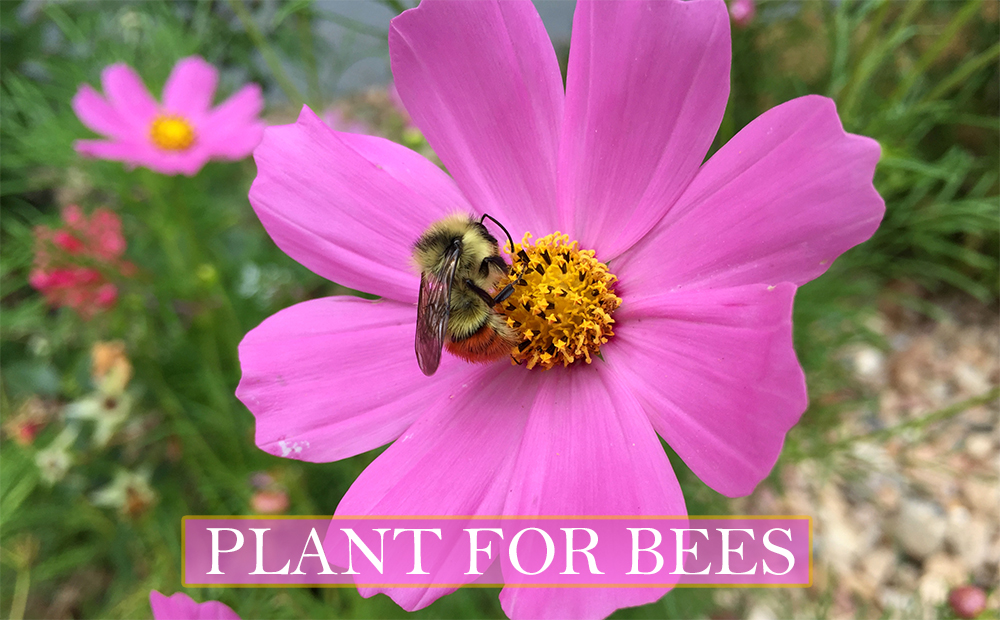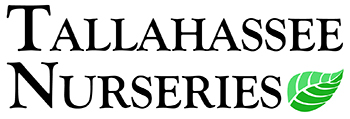
Pollinators of all types play an absolutely vital role in so many ways but, today we want to focus on bees. Studies show that one third of the food we consume relies on pollination from bees! Here are a few important considerations when planting for bees.
Bloom Time
Having something in bloom year-round is crucial for supporting all types of bees. This is great for bees and keeping your yard full of color!
Color
Having a variety of colors of flowers ensures that many different kinds of bees will be attracted to something that’s blooming in your yard.
Plant more than one
Bees, in particular honeybees, are drawn especially to mass plantings of one type of flower. Try planting clusters of each type of flower rather than single specimens.
Limit pesticide use
Any insecticide, even natural ones, can be harmful to bees. If you must use a pesticide in your garden, spray only when the sun is down, and try to avoid
getting it on the flowers where the pollinators may come in contact with it. Always follow label instructions on pesticides. Remember, insecticides are designed to kill insects, but a bee friendly garden should be insect-friendly!
Look for open-faced flowers
Make it obvious! Bees tend to prefer blooms that have visible pollen that is easy for them to access. (Avoid hybrids with double blooms, as the extra petals can get in the bees’ way.)
Don’t forget the trees!
Trees are arguably the most important food resource for bees. They produce more flowers than a small annual or perennial, and often have more nutritional value for the bees.
The Best Plants for Bees!
This list is compiled from research and personal experience of Tallahassee Nurseries staff members. It must be understood that certain plants will attract different pollinators at different times of year. There is only limited research on the actual nutritional value of pollen and nectar from specific plants, so we can only assume that what is visited most frequently by bees is also the most beneficial for them.
Plants notated with *HB* seem to be the best attractors for honeybees specifically, from our observations and research. The others may mostly support native bees, which are also very important and should not be forgotten.
- Bidens – Bidens ferulifolia *HB*
- Celosia – Celosia spp.
- Bacopa – Chaenostoma cordatum
- Partridge Pea – Chamaecrista fasciculata
- Cosmos – Cosmos spp.
- Mexican Heather – Cuphea hyssopifolia *HB* (Purple or White)
- California Poppy – Eschscholzia californica
- Lavender – Lavendula spp. *HB*
- African Blue Basil – Ocimum kilimandscharicum × basilicum ‘Dark Opal’ *HB*
- Pentas – Pentas lanceolate
- Moss-rose Purslane – Portulaca grandiflora
- White Clover – Trifolium repens *HB*
- Zinnias – Zinnia elegans
- Anise Hyssop – Agastache foeniculum *HB*
- Milkweed – Asclepias curassavica & Asclepias tuberosa *HB*
- Native Milkweed – Asclepias incarnata *HB*
- Coreopsis – Coreopsis spp.
- Purple Coneflower – Echinacea purpurea *HB*
- Blanket Flower – Gaillardia spp.
- Swamp Sunflower – Helianthus angustifolius
- Blazing Star – Liatris spicata
- Powderpuff Mimosa – Mimosa strigillosa *HB*
- Bee Balm – Monarda punctata
- Russian Sage – Perovskia atriplicifolia
- Drummond Phlox – Phlox drummondii
- Black-Eyed Susan – Rudbeckia spp.
- Black & Blue Salvia – Salvia guaranitica *HB*
- Mystic Spires Salvia – Salvia ‘Mystic Spires’ *HB*
- Autumn Joy Sedum – Sedum ‘Autumn Joy’ *HB*
- Goldenrod – Solidago odora *HB*
- Giant Ironweed – Vernonia gigantea
- Maples – Acer spp. *HB*
- Sweet Almond Bush – Aloysia virgata *HB*
- Native Beautyberry – Callicarpa Americana
- High Fragrance Camellia – Camellia lutchurnsis ‘High Fragrance’
- Kanjiro Camellia – Camellia sasanqua ‘Kanjiro’
- Redbud – Cercis canadensis *HB*
- Spring/Black Titi – Cliftonia monophyla *HB*
- Native Dogwood – Cornus florida
- Dahoon Holly – Ilex cassine *HB*
- Burford Holly – Ilex cornuta *HB*
- Galberry – Ilex glabra
- American Holly – Ilex opaca *HB*
- Tulip Poplar – Liriodendron tulipifera
- Fetterbush – Lyonia lucida
- Chinese Mahonia – Mahonia fortune *HB*
- Apples – Malus spp. *HB*
- Banana – Musa spp. *HB*
- Tupelo – Nyssa spp. *HB*
- Plums – Prunus spp. *HB*
- Taiwan Cherry – Prunus campanulata *HB*
- Indian Hawthorn – Raphiolepis indica *HB*
- Black Locust – Robinia pseudoacacia
- Blackberry – Rubus spp. *HB*
- Cabbage Palm – Sabal palmetto *HB*
- Willows – Salix spp.
- Elderberry – Sambucus nigra spp canadensis
- Saw Palmetto – Serenoa repens *HB*
- Chaste Tree – Vitex agnus-castus
- Devil’s Walking Stick – Aralia spinosa
- Agapanthus
- Tea Camellia – Camellia sinensis
- Camellia Hiryu
- Camellia Setsugekka
- Blueberries – Vaccinium virgatum
- St. John’s Wort – Hypericum tenuifolium
- Pineapple Sage – Salvia elegans
- Spanish Needles – Bidens Alba *HB*
- Thistles – Cirsium horridulum *HB*
- Mexican clover – Richardia grandiflora *HB*
- Dog fennel – Eupatorium capillifolium *HB*
- Virginia Creeper – Parthenocissus quinquefolia *HB*
Sources:
- Rodale’s Organic Life
- UF/IFAS Leon County Extension: Blogs
*This article was written by Kaelin Riché (Tallahassee Nurseries Employee, FNGLA Florida Certified Horticulture Professional) using years of personal observations growing in the Tallahassee area.





